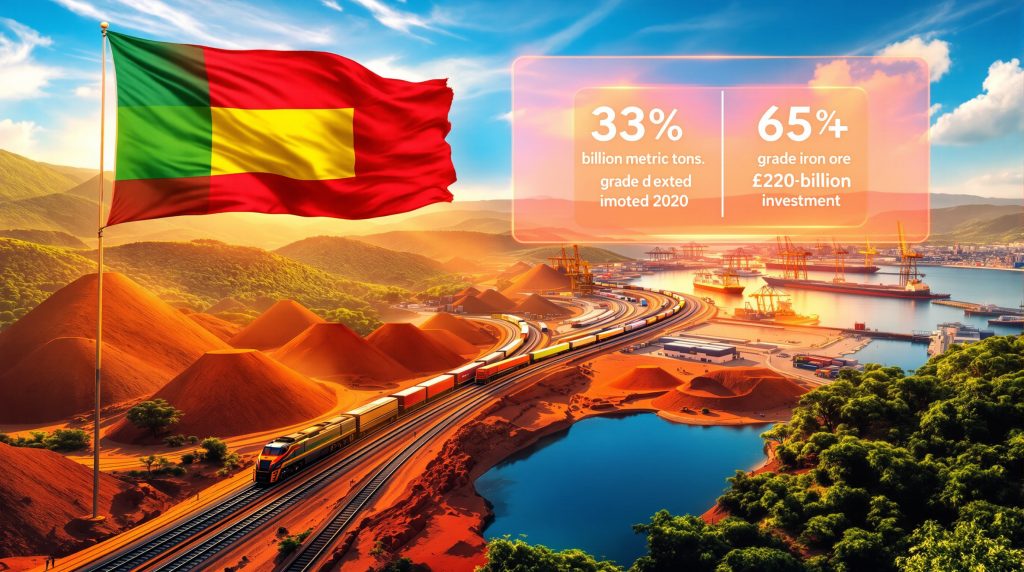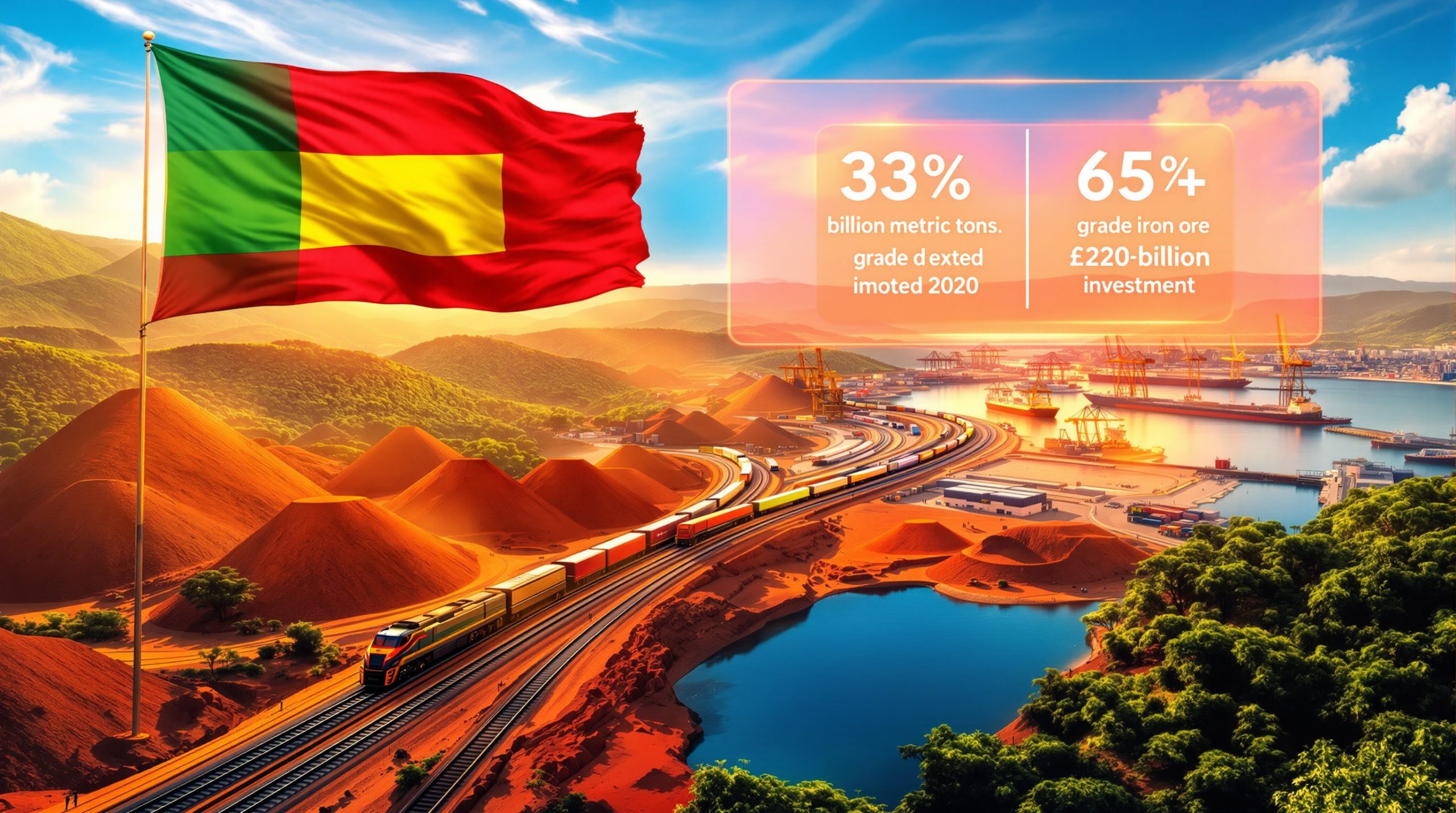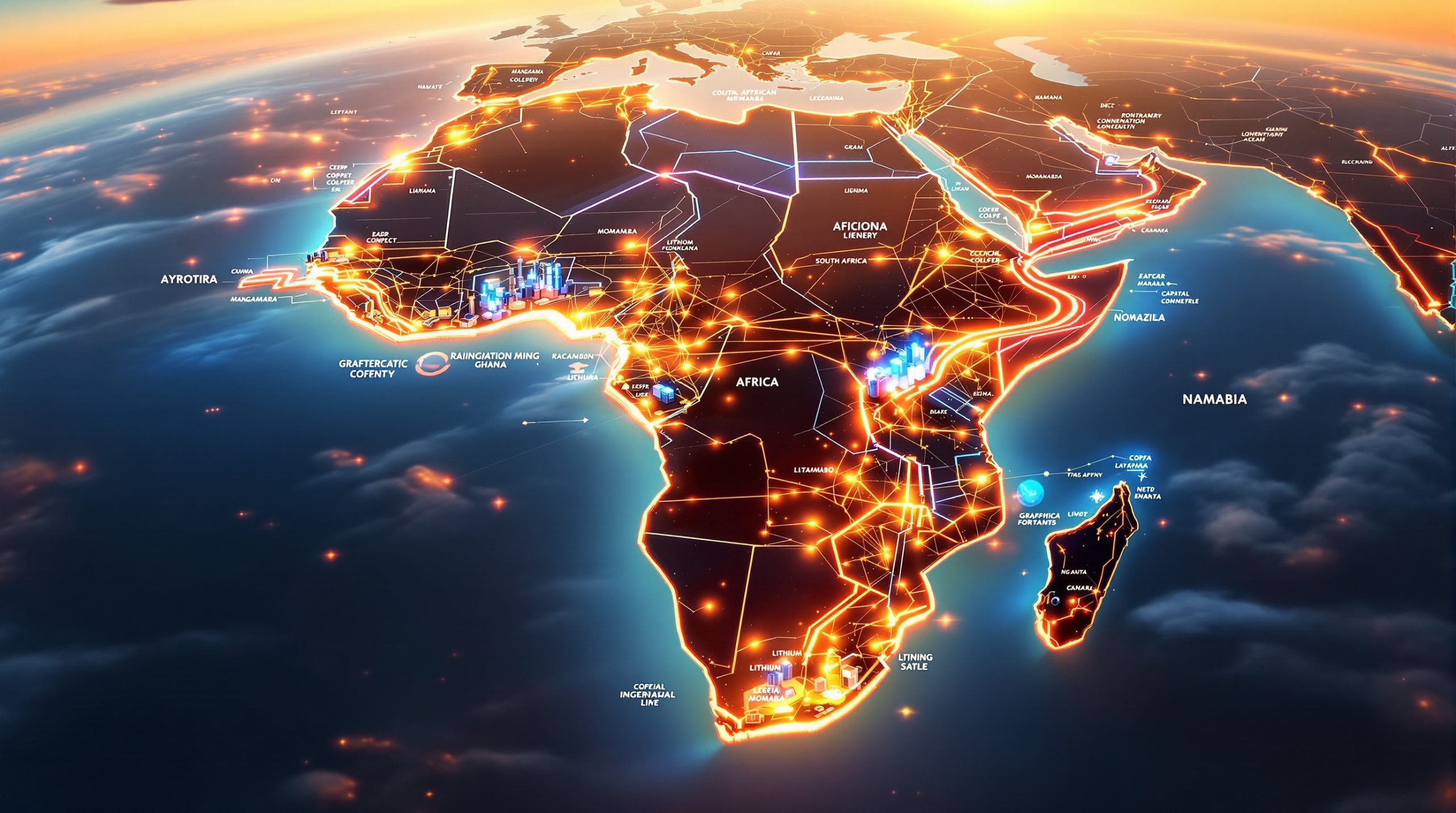Guinea's Mining Revolution: Understanding the Simandou Integrated Project's Scale
The inauguration of the Simandou Integrated Project represents a transformative moment for Guinea's mining sector, establishing the nation as a formidable presence in global iron ore markets. This comprehensive development combines high-grade iron ore extraction with continental railway infrastructure and deep-water port facilities, creating an integrated mining-to-export system that positions Guinea among the world's leading iron ore exporters.
Guinea's mineral sector has experienced unprecedented expansion, with the Simandou development serving as the cornerstone of national economic transformation. The project encompasses iron ore deposits containing exceptionally high-grade material at 65% iron content, significantly above industry averages and positioning these resources as premium commodities in global steel production markets.
The scale of investment exceeds $20 billion USD, representing one of Africa's largest mining infrastructure developments and demonstrating international confidence in Guinea's mining potential. This massive financial commitment reflects the strategic importance of securing high-quality iron ore supplies in an increasingly competitive global market.
International attendance at the project's inauguration ceremony, including President Paul Kagame of Rwanda, President Brice Clotaire Oligui Nguema of Gabon, Vice Premier Liu Guozhong of China, Prime Minister Robert Beugré Mambé of Côte d'Ivoire, and Prime Minister David Moinina Sengeh of Sierra Leone, underscores the regional and global significance of this achievement.
The Two-Decade Journey: From Vision to Operational Reality
The path to the inauguration of the Simandou Integrated Project required overcoming significant obstacles that had prevented development for more than two decades. Previous attempts to develop these resources failed due to complex logistical challenges, financing constraints, and the absence of integrated infrastructure solutions connecting inland deposits to international markets.
The breakthrough came through establishing the Compagnie du TransGuinéen (CTG) in July 2022, which brought together top Guinean and international experts in engineering, logistics, and mining development. This joint management structure proved crucial in coordinating the complex technical requirements of simultaneously developing mining operations, railway infrastructure, and port facilities.
Guinea's government secured a 15% contributive and non-dilutive participation in the entire project, ensuring national control over strategic infrastructure while maintaining access to international expertise and capital. This ownership structure balances foreign investment requirements with national sovereignty objectives, creating a model for resource development that preserves strategic control.
The project partnership encompasses international operators including Baowu Steel, Chinalco, Rio Tinto, and Winning International, combining Chinese engineering capabilities with established mining expertise. Furthermore, this collaboration demonstrates how Rio Tinto's green steelmaking technology can unlock complex resource developments that individual entities might struggle to complete independently.
Development proceeded in full compliance with the highest international technical, social, and environmental standards, addressing previous concerns about responsible resource extraction in the region. This commitment to international best practices helped secure the broad stakeholder support necessary for project completion.
Strategic Partnership Architecture: Balancing International Expertise with National Control
The Simandou project's partnership structure represents a sophisticated approach to large-scale resource development that balances multiple stakeholder interests while maintaining operational efficiency. The Compagnie du TransGuinéen serves as the central coordinating entity, ensuring seamless integration between mining, transportation, and export operations.
Guinea's 15% participation provides meaningful national involvement without creating operational constraints that might impede project efficiency. This ownership model ensures government input in strategic decisions while allowing international partners to apply their technical expertise and operational experience.
The international partnership brings together complementary strengths: Rio Tinto contributes established mining operational expertise, whilst Chinese partners provide infrastructure development capabilities and manufacturing industry connections. This combination addresses both the technical challenges of iron ore extraction and the market access requirements for successful commercialisation.
Key partnership advantages include:
• Risk Distribution: Shared financial exposure across multiple international entities
• Technical Integration: Combined expertise in mining, infrastructure, and logistics
• Market Access: Direct connections to major steel-producing regions
• Operational Efficiency: Coordinated management through single entity structure
The partnership model demonstrates Guinea's capacity to negotiate complex international agreements that preserve national interests while securing necessary foreign investment and technical capabilities.
Trans-Guinean Railway: Engineering Continental Connectivity
The 650-kilometre dual-track TransGuinéen railway represents far more than mining logistics infrastructure, creating Guinea's first modern continental transportation corridor connecting previously isolated inland regions to international markets. This railway system will facilitate the transport of passengers, goods, and agricultural products, establishing a genuine economic corridor that extends benefits beyond mining operations.
The dual-track design enables simultaneous bidirectional traffic, supporting both outbound iron ore shipments and inbound supply deliveries whilst accommodating passenger and general freight services. This multi-use approach maximises infrastructure utilisation and creates additional revenue streams beyond mining operations.
Railway construction required overcoming significant geographical challenges, including varied terrain conditions and the need to maintain consistent gradients suitable for heavy freight transport. Moreover, the engineering specifications reflect international railway standards adapted to local conditions and operational requirements.
Regional integration benefits include:
• Agricultural Product Transport: Enabling inland farmers to access coastal markets
• Passenger Services: Connecting remote communities to economic centres
• General Freight: Supporting broader economic development across regions
• Emergency Access: Providing transportation infrastructure for humanitarian purposes
The railway's completion creates long-term economic opportunities that extend well beyond the mining sector, positioning this infrastructure as a catalyst for broader regional development initiatives.
Morébayah Port: Transforming Coastal Infrastructure
The development of Morébayah port facilities represents a remarkable transformation of Guinea's coastal infrastructure, creating deep-water capabilities specifically designed for bulk iron ore export whilst accommodating broader maritime trade requirements. The port's inauguration ceremony location demonstrated its operational readiness and strategic importance.
Port infrastructure includes specialised iron ore handling equipment designed to efficiently transfer materials from railway cars to ocean-going vessels, minimising handling time and reducing operational costs. The facility's design incorporates modern bulk handling technologies that ensure consistent loading rates and minimise environmental impact.
The deep-water design enables access by large bulk carriers, improving transportation economics and providing flexibility in global market access. This capability proves particularly important for accessing distant markets where transportation costs significantly impact competitiveness.
Strategic location advantages include:
• Atlantic Ocean Access: Direct shipping routes to European and American markets
• Reduced Transportation Costs: Integrated mine-to-port logistics
• Operational Efficiency: Purpose-built infrastructure for iron ore handling
• Multi-Purpose Capability: Accommodation of general cargo operations
The port's successful development demonstrates Guinea's capacity to execute complex infrastructure projects within compressed timeframes whilst maintaining international operational standards. Operations began at the Simandou iron ore project after years of careful planning and international cooperation.
Meeting Global Decarbonisation: High-Grade Ore's Strategic Value
The Simandou deposit's exceptionally high iron content of 65% positions Guinea as a strategic player in the emerging green iron economy, where high-grade ores become essential for low-carbon steel production processes. This quality advantage addresses growing global demand for materials that enable more efficient, environmentally responsible steel manufacturing.
High-grade iron ore reduces energy requirements in steel production by minimising the processing needed to remove impurities and achieve desired iron concentrations. Consequently, this efficiency translates directly into reduced carbon emissions per ton of steel produced, supporting global decarbonisation objectives in heavy industry.
Steel manufacturers face increasing pressure to reduce their environmental impact, creating premium demand for high-quality raw materials that enable cleaner production processes. However, understanding iron ore trends remains crucial for assessing Guinea's ore quality and its competitive advantages in this evolving market environment.
Market positioning strengths include:
• Superior Energy Efficiency: Reduced processing requirements lower production costs
• Environmental Compliance: High-grade ore supports low-carbon steel initiatives
• Premium Pricing: Quality advantages command market premiums
• Long-Term Demand: Sustainability requirements drive continued preference for high-grade materials
The global transition toward low-carbon steel production creates sustained demand for high-quality iron ore, positioning Guinea's resources as strategically valuable for decades to come.
Supply Chain Diversification: Reducing Global Concentration Risks
Guinea's entry into major iron ore production addresses growing concerns about supply concentration in global markets, where Australian and Brazilian producers have historically dominated export volumes. This geographic diversification provides steel manufacturers with additional sourcing options and improved supply security.
The Simandou project's integrated infrastructure design provides cost advantages compared to operations requiring third-party transportation services, enabling competitive pricing in international markets. These operational efficiencies support long-term customer relationships and sustainable market positioning.
Geographic proximity to European markets offers shipping cost advantages for certain destinations whilst Atlantic Ocean access enables flexible market targeting based on demand conditions and pricing opportunities. In addition, this operational flexibility proves particularly valuable during market volatility periods.
Competitive advantages in global markets include:
• Reduced Supply Concentration: Alternative sourcing for major steel producers
• Shipping Flexibility: Atlantic access enables diverse market targeting
• Cost Competitiveness: Integrated operations reduce transportation expenses
• Quality Consistency: High-grade ore supports premium market positioning
The project's successful completion provides important supply diversification benefits for global steel production whilst establishing Guinea as a reliable long-term supplier in international markets. Furthermore, the global mining landscape continues to evolve as new suppliers enter established markets.
Simandou 2040: National Transformation Through Resource Development
The fifteen-year Simandou 2040 Sustainable and Responsible Socioeconomic Development Program extends far beyond mining operations, targeting comprehensive national economic transformation through strategic deployment of resource revenues. This program foresees total investment exceeding $200 billion to foster inclusive growth, job creation, and long-term value generation.
Structured into three five-year phases, the program aims to make the megaproject's resources a driver of shared and lasting prosperity for Guinea. This systematic approach ensures resource revenues contribute to sustainable development rather than creating temporary economic benefits without lasting impact.
The program's comprehensive scope addresses fundamental development challenges whilst building upon the infrastructure foundation established through the Simandou project. This integrated approach maximises the multiplier effects of initial mining investments.
Program implementation focuses include:
• Infrastructure Development: Transportation, power generation, and telecommunications expansion
• Education and Healthcare: Human capital development and social service improvement
• Economic Diversification: Manufacturing development and agricultural modernisation
• Technology Transfer: Knowledge acquisition and innovation capacity building
The program represents Guinea's commitment to converting mineral wealth into lasting prosperity through disciplined investment in productive capacity and human development initiatives.
Operational Complexities: Managing Integrated Systems
Successfully operating an integrated mine-rail-port system requires sophisticated coordination across multiple technical domains, ensuring seamless material flow from extraction through export whilst maintaining consistent quality standards and operational efficiency. This coordination demands continuous monitoring and predictive maintenance protocols.
Real-time logistics management becomes crucial for optimising material flow and minimising bottlenecks that could impact overall system performance. Advanced monitoring systems enable proactive identification of potential issues before they affect operations.
The integrated approach provides operational advantages but also creates interdependencies where problems in one component can affect the entire system. For instance, integrated mine planning becomes essential, and robust maintenance protocols and backup systems help ensure operational continuity.
Critical operational requirements include:
• Coordinated Scheduling: Synchronising mining, transport, and shipping operations
• Quality Control: Maintaining consistent ore specifications throughout the system
• Maintenance Planning: Predictive maintenance to prevent system disruptions
• Environmental Monitoring: Continuous compliance with environmental standards
"Managing complex integrated systems requires sophisticated coordination capabilities and continuous monitoring to ensure optimal performance across all components."
The project's operational complexity demonstrates Guinea's technical capabilities whilst highlighting the importance of international expertise in managing world-class mining operations.
Sustainable Development: Balancing Growth with Environmental Responsibility
Converting mineral wealth into lasting prosperity requires careful management of resource revenues whilst avoiding common challenges associated with resource-dependent economies. Guinea must balance immediate economic benefits with long-term diversification objectives to ensure sustainable development outcomes.
The project's development adhered to comprehensive environmental and social impact frameworks, incorporating international best practices for large-scale mining operations. These standards address community engagement, environmental protection, and biodiversity conservation measures throughout the operational lifecycle.
Environmental compliance extends beyond regulatory requirements, incorporating climate resilience planning and ecosystem restoration commitments. These measures aim to ensure mining operations contribute positively to regional development whilst minimising environmental impact.
Sustainability framework components include:
• Environmental Impact Mitigation: Comprehensive protection and restoration measures
• Community Benefit-Sharing: Local development programs and employment creation
• Cultural Heritage Protection: Preservation of historical and cultural sites
• Biodiversity Conservation: Ecosystem protection and restoration initiatives
The project's commitment to international environmental and social standards demonstrates that large-scale resource development can proceed responsibly whilst delivering significant economic benefits.
Global Market Position: Establishing Guinea as a Mining Leader
The successful inauguration of the Simandou Integrated Project establishes Guinea as a model for African mineral development, demonstrating how strategic partnerships can unlock resource potential whilst maintaining national sovereignty. This achievement influences similar developments across the continent.
Guinea's entry into major iron ore production occurs during favourable market conditions, with growing demand for high-quality ores supporting premium pricing opportunities. However, the project's integrated infrastructure design provides cost advantages that support competitive positioning in global markets.
The project's technological innovations and partnership models may influence future mining developments worldwide, particularly in regions where infrastructure constraints have historically limited resource development. These innovations provide scalable approaches for similar projects.
Market leadership implications include:
• Regional Influence: Demonstrating successful large-scale development models
• Technology Innovation: Advanced approaches to integrated mining operations
• Partnership Models: Effective structures for international resource development
• Economic Sovereignty: Balanced approaches to foreign investment and national control
Minister and Chief of Staff Djiba Diakité characterised the achievement as foundational to Guinea asserting itself as a key player in sustainable development and economic sovereignty in West Africa, highlighting the broader regional significance of this accomplishment.
Investment and Technology Innovation: Advancing Mining Sector Standards
The project's successful integration of modern mining technology with traditional infrastructure development demonstrates scalable approaches for similar developments worldwide. These technological advances may influence future mining project designs across emerging markets.
Advanced engineering solutions developed for the Simandou project address challenges common to many African mining developments, including infrastructure integration, environmental compliance, and operational efficiency optimisation. Moreover, mining innovation trends and these innovations provide templates for future projects.
The combination of international best practices with local conditions creates operational models that balance efficiency requirements with environmental and social responsibilities. This approach demonstrates that world-class operations can be achieved whilst maintaining comprehensive sustainability standards.
Technology and innovation highlights include:
• Integrated Systems Design: Seamless coordination between mining, transport, and export operations
• Environmental Technology: Advanced monitoring and mitigation systems
• Operational Efficiency: Modern equipment and process optimisation
• Quality Control: Consistent product specifications throughout the supply chain
The project's technological achievements establish new benchmarks for mining operations in challenging environments whilst demonstrating the feasibility of complex integrated developments.
Economic Transformation: Beyond Mining Operations
The inauguration of the Simandou Integrated Project marks more than the beginning of iron ore production; it represents the engine of national transformation that reflects presidential vision and popular determination to build a future of shared prosperity. This collective achievement demonstrates Guinea's capacity to deliver world-class projects within record timeframes.
Economic transformation extends beyond direct mining revenues to encompass infrastructure development, technology transfer, and human capital advancement that create lasting benefits for Guinea's population. The integrated approach ensures maximum economic impact from resource development.
The project's success creates demonstration effects that may attract additional investment in Guinea's mining sector and broader economy, establishing the nation as a preferred destination for responsible resource development partnerships. Africa's largest iron ore project starts operations with significant implications for regional development.
Long-term economic benefits include:
• Revenue Generation: Substantial government income from mining operations
• Employment Creation: Direct and indirect job opportunities across sectors
• Infrastructure Legacy: Transportation and port facilities supporting broader economic development
• Technology Transfer: Knowledge and skills development in mining and logistics sectors
The transformation represents Guinea's emergence as a major player in global commodity markets whilst establishing frameworks for sustainable resource-based development that can serve as models for other African nations.
Disclaimer: This analysis is based on publicly available information from the project's inauguration and may not reflect all technical specifications or operational details. Investment decisions should be based on comprehensive due diligence and professional financial advice. Mining operations involve inherent risks including commodity price volatility, operational challenges, and regulatory changes that may affect project economics.
Ready to Discover the Next Major Mining Breakthrough?
Discovery Alert instantly identifies significant ASX mineral discoveries using its proprietary Discovery IQ model, delivering real-time alerts that transform complex geological data into actionable investment opportunities. Visit Discovery Alert's discoveries page to explore historic examples of exceptional returns from major mineral discoveries and begin your 30-day free trial to position yourself ahead of the market.




